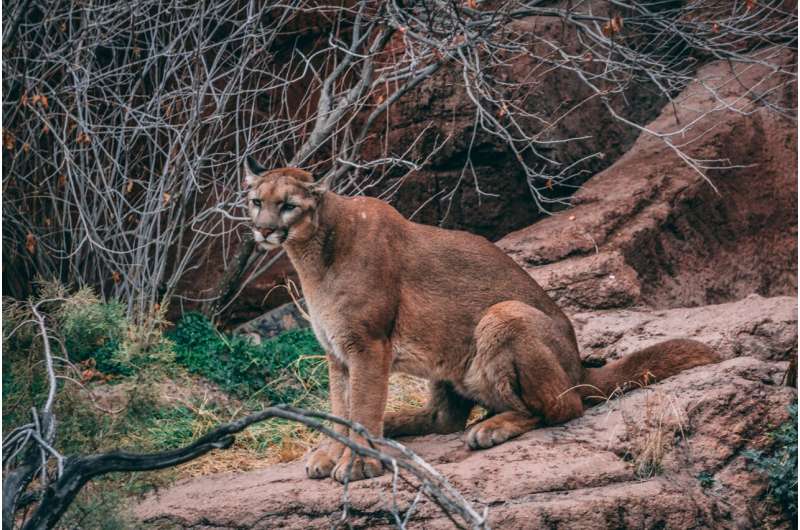Hunting by humans can change virus evolution, transmission in pumas

Pumas are famously solitary creatures. They typically avoid contact with humans, which makes them a challenge to observe. As a result, very little is known about their movements and even less about how diseases move through puma populations.
A new study published in Nature Ecology & Evolution—led by the University of Minnesota with Colorado State University and Colorado Parks and Wildlife researchers—offers rare insight into the pathway of a common virus in two geographic areas with different wildlife management strategies. The research has implications for the ongoing SARS-CoV-2 pandemic, which potentially emerged following wildlife-to-human transmission.
The study, funded by the National Science Foundation, traces the transmission of feline immunodeficiency virus in these wild cats using DNA to identify patterns of evolution across puma viral genomes. CSU's lead researcher, Dr. Sue VandeWoude, a veterinary scientist, has specialized in studying conditions affecting cats, big and small, including feline immunodeficiency virus or FIV, which can leave animals vulnerable to other infections.
VandeWoude said that while the study does not specifically relate to SARS CoV-2, it does analyze fundamental principles of disease dynamics in wildlife.
"SARS-CoV-2 has been shown to infect domestic and nondomestic felids or members of the cat family, as well as white-tailed deer in the wild," said VandeWoude, a Colorado State University Distinguished Professor and director of the One Health Institute at CSU. "It is feasible that a wild puma could become infected following contact with domestic cats or deer shedding the virus."
Researchers studied puma DNA samples over a 10-year period
Meggan Craft, a professor in the University of Minnesota's College of Biological Sciences, and Nick Fountain-Jones, a research associate at the University of Tasmania who previously worked in Craft's lab, led the study.
Craft and Fountain-Jones worked with colleagues at CSU and Colorado Parks and Wildlife to gather puma DNA samples in two comparable regions of the state over a 10-year period and to sequence the virus. In one region, hunting was banned for five years and then reinstated. In the other region, hunting was less commonly practiced.
The research team found that in the region where hunting was banned and then reinstated, disease transmission dynamics changed markedly. Less hunting led to higher levels of disease transmission and occurred primarily among males. Since hunters tend to target males, there were more males present during the no-hunting period, which potentially increased competition for territory and a higher likelihood of male-to-male contact which could lead to disease spread.
"We had a unique opportunity to test what happens when a population is changed by hunting," said Craft, who studies the spread of diseases in animal populations. "Our approach enabled us to provide insights into the cascading consequences of hunting and the cessation of hunting on host-pathogen dynamics."
The researchers noted that changes in wildlife management can have unexpected consequences.
"The key lesson from our research is that whenever management changes for a species, enhanced disease surveillance is a smart idea as there can be unintended consequences for virus evolution and spread," said Fountain-Jones.
VandeWoude agreed. "Human impacts on wildlife, including hunting, can significantly alter the way diseases spread among populations because of changes of behavior," she said. "This is not too surprising, but it underscores how relocating, displacing or harvesting animals results in changes in the way diseases can spread, with potentially more chance for spillover or enhanced viral evolution that could change virulence and the range of the host."
Craft, who is known internationally for her work in disease modeling in ecological systems, has published more than a dozen other papers relating to disease transmission in wild and domestic felids, members of the cat family. Her laboratory uses empirical data generated by collaborators to model disease transmission that is widely applicable across other wildlife disease systems.
Future studies will further analyze puma behavior and movements to better understand the circumstances in which the disease is transmitted in different ecosystems.Viral evolution in animals could reveal future of COVID-19
More information: Nicholas M. Fountain-Jones et al, Hunting alters viral transmission and evolution in a large carnivore, Nature Ecology & Evolution (2022). DOI: 10.1038/s41559-021-01635-5
Journal information: Nature Ecology & Evolution
Provided by Colorado State University
No comments:
Post a Comment